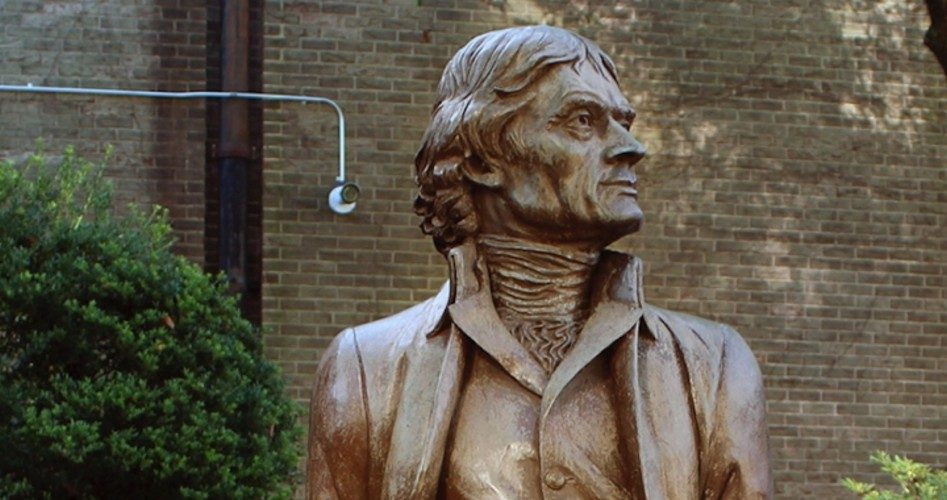
Some left-wing students at Hofstra University (located near New York City) participated Friday in what they are calling the second annual “Jefferson Has Gotta Go!” event. The Jefferson that they are referring to is a statue of the third president of the United States, and the author of the Declaration of Independence.
They argue that Thomas Jefferson represents slavery and racism, and that his stature should not be displayed “on a college campus, especially not in front of a hub of student life.”
In a petition, the students argued, “Jefferson’s values aided in the construction of institutionalized racism and justified the subjugation of black people in the United States. Jefferson has been embraced as an icon by white supremacists and neo-Nazi organizations such as the Ku Klux Klan and online white supremacist chat rooms.”
Hofstra’s College Democrats have publicly supported the drive to take down the statue of one of the greatest of the Founding Fathers. Miranda Pino, a former board member of the Democratic group, argued that the statue represents a “legacy of racism and bigotry on college campuses.”
Not all Hofstra students agree with the desire to remove the Jefferson statue. Richard Caldwell, a Hofstra student, recently released a counter-petition — “KEEP The Jefferson Statue at Hofstra University.” The counter-petition argues that for “thousands of years, tyranny reined supreme as the most widely used form of government. Thomas Jefferson wrote the document that changed all that. The Declaration of Independence was written by Thomas Jefferson and put forth the idea that freedom … should ring loudest.”
The counter-petition has garnered hundreds of signatures. Petition author Caldwell told Campus Reform noted the “magnitude of Jefferson’s accomplishments. We all acknowledge he was flawed in aspects, sadly a byproduct of his time.”
Certainly, Jefferson was flawed — he was a human being, after all — and certainly he was a “byproduct of his time,” but he also exhibited qualities and accomplishments that we today — including the ignorant detractors at Hofstra — are beneficiaries of. The arguments comparing him to the KKK, and that he is somehow an icon of slavery, demonstrate the ignorance that is unfortunately endemic among many college students today.
While Jefferson did continue to own slaves until the end of his life, some perspective is in order. As a legislator in Virginia, he supported the end to the trans-Atlantic slave trade. It was Jefferson’s leadership, more than any other single person, who got a ban on slavery implemented in the Northwest Ordinance for the Northwest Territory in 1787. He wanted to include a denunciation of slavery in the Declaration of Independence in 1776, but he was overruled.
Writing in Thomas Jefferson: A Life, historian Willard Sterne Randall, said Jefferson used examples of talented blacks, who were not “degraded and intellectually stunted by the institution of slavery” to refute those who argued for the natural inferiority of blacks. “Nothing is more certainly written in the book of fate than that these people are to be free,” he wrote of the slaves. He believed that with the progress of time, social evils such as slavery would be eradicated, and advanced various schemes that would accomplish that, both gradually and peacefully.
But it was his view that freeing the slaves without their being self-sufficient as cruel and irresponsible. He had freed his favorite chef, James Hemings, but Hemings, unable to support himself, eventually begged to be allowed to return to Monticello. Sadly, Hemings eventually killed himself. No doubt this greatly distressed Jefferson, and hardened his resolve that emancipation without the ability to support oneself was unwise.
The truth is that Jefferson was not in any financial condition to free his slaves. When he died, he was more than $100,000 in debt. Since the slaves were part of the collateral for those massive debts, they were no longer his to free.
What this agitation at Hofstra is really all about is denigrating those men who founded our nation as a constitutional republic, with a limited government. When the anti-Confederate frenzy began, with its targeting of statues of Confederate icons, many observers warned that this Taliban-like assault was just the beginning of a broader effort to destroy the foundations of that constitutional republic. The Confederates were just the low-hanging fruit, so to speak. Once the precedent was established of tearing down statues of men such Robert E. Lee, the cultural subverters would soon turn to men such as Jefferson and George Washington.
One African-American student at Hofstra, Christian Ray Conrad, seems to get it. He told Campus Reform, “Given my ethnic background, I wholeheartedly support the fight against racism, but the methods of these people is just going to cause more problems than they fix. I feel like more people want to keep the statue to honor Jefferson’s memory. However, the louder, more outspoken group happens to be those against keeping it. Jefferson did so much for us as a nation — a small nation — with little in the way of reputation, the least we can do for him is honor his memory and keep as legacy as pure and historically accurate as possible.”
Well said. Unfortunately, such sentiments are not shared by those leftist Taliban-types whose idea of a debate is to shout down the opposition and destroy anything they do not like, in order to advance their radical agenda.
Steve Byas is the author of History’s Greatest Libels, which includes a chapter on Thomas Jefferson. Other chapters defend such historical figures as Christopher Columbus, Marie Antoinette, Clarence Thomas, and Joseph McCarthy from libelous allegations.
Photo of Thomas Jefferson’s statue at Hofstra University: AP Images

